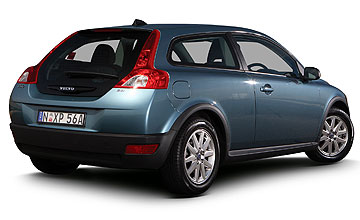BY BYRON MATHIOUDAKIS | 13th Feb 2008

Remember the Ford Capri?
No, not the front-wheel drive convertible of the late 1980s, but the two-door, Mustang-style coupe based on the contemporary Ford Escort small car of the early 1970s?
That bombed in Australia, but it helped to inspire the Toyota Celica, a ‘personal’ two-plus-two coupe derived from a small Japanese car.
With head-turning design, a four-seater interior with some practicality and the promise of something fresh and exciting, the Celica over seven generations went on to do big things for its maker until new-car buyers lost their will to live and bought boring compact SUVs instead.
Just 12 years ago there were around a dozen sub-$40,000 two-plus-two coupes and now there is just one… and that’s the almost invisible Hyundai Tiburon – a car as youthful as John Travolta returning to Saturday Night Fever today.
Everything else is too closely related to the car that spawned it (Holden Astra Coupe, Citroen C4 VTR/S), too compromised as a package (Peugeot 207 CC), too expensive (BMW 3 Series Coupe), a mixture of most of the things above (sorry Mini) or too dead (goodbye Honda Integra – we miss you already).
But Volvo – maker of the super-sensible shoes 240DL and still-in-the-carton-it-came-in 740 Estate – hasn’t forgotten.
Its new entry-level C30 S sounds refreshingly similar to the original Capri/Celica brief: utterly stylish yet somewhat practical absolutely affordable (at a smidge under $35K it undercuts the final Celica SX by $6000) four-seater interior with a coupe-esque taper in the rear and run-of-the-mill (ish) small-car (Ford Focus-derived via the Volvo S40 small car) platform.
Of course, in true sporty coupe fashion, the C30 S is not the sharpest drive, as it seems to be set-up for comfort rather than absolute steering and handling precision. You are more likely to notice how well it rides rather than how tightly this Swedish Celica corners.
Having said that though, drive the front-wheel drive Volvo hard and the very rightness of its ‘basic’ ingredients – a taut body, multi-link independent rear suspension, electro-hydraulic rack and pinion steering – reveals a small car with capable, linear and safe dynamics.
The 125kW 2.4-litre twin-cam five-cylinder petrol engine is no slouch at all, endowing the C30 with a terrific turn of speed that includes a handy wad of torque from down low for front-tyre burning antics, as well as a nicely gruff exhaust that sounds like it means business.
And we’re talking about the five-speed Geartronic automatic with its Tiptronic-style sequential shifter we’re sure the five-speed manual would be even more responsive – although the lack of a six-speeder in this day and age is really just cynical product planning. Even the base Nissan Tiida ST offers one, and so – finally – does the base BMW 1 Series hatch.
Never mind. Throw in a really rather special interior – revealed in the C30’s high shoulder line, ultra-low glass tailgate, metallic floating centre console, rock-solid build quality, beautifully crisp instruments, well-weighted controls and superb ergonomics – and the Volvo’s freshness and specialness shine through (unless you already own a current-model S40 or V50 and are bored with the identical dashboard design).
Obviously, being a premium brand, Volvo charges plenty for options that can transform your somewhat austere but very architecturally sound C30 into something pretty unique. Unfortunately, a $2190 slug for DSC stability control is a bit rich for the Swedish firm that has traded on safety for decades now. Mitsubishi’s Lancer has it at $21K.
Yet we like the base model C30 anyway.
It looks very smart drives with an energy and enthusiasm that is pretty much absent from your base-model Mini, 207 CC and 1 Series (but not the Tiburon, it must be said) can certainly ride and handle well and makes you feel special.
Perhaps the ‘C’ stands for something else rather than coupe? This Volvo is certainly no silly-car.